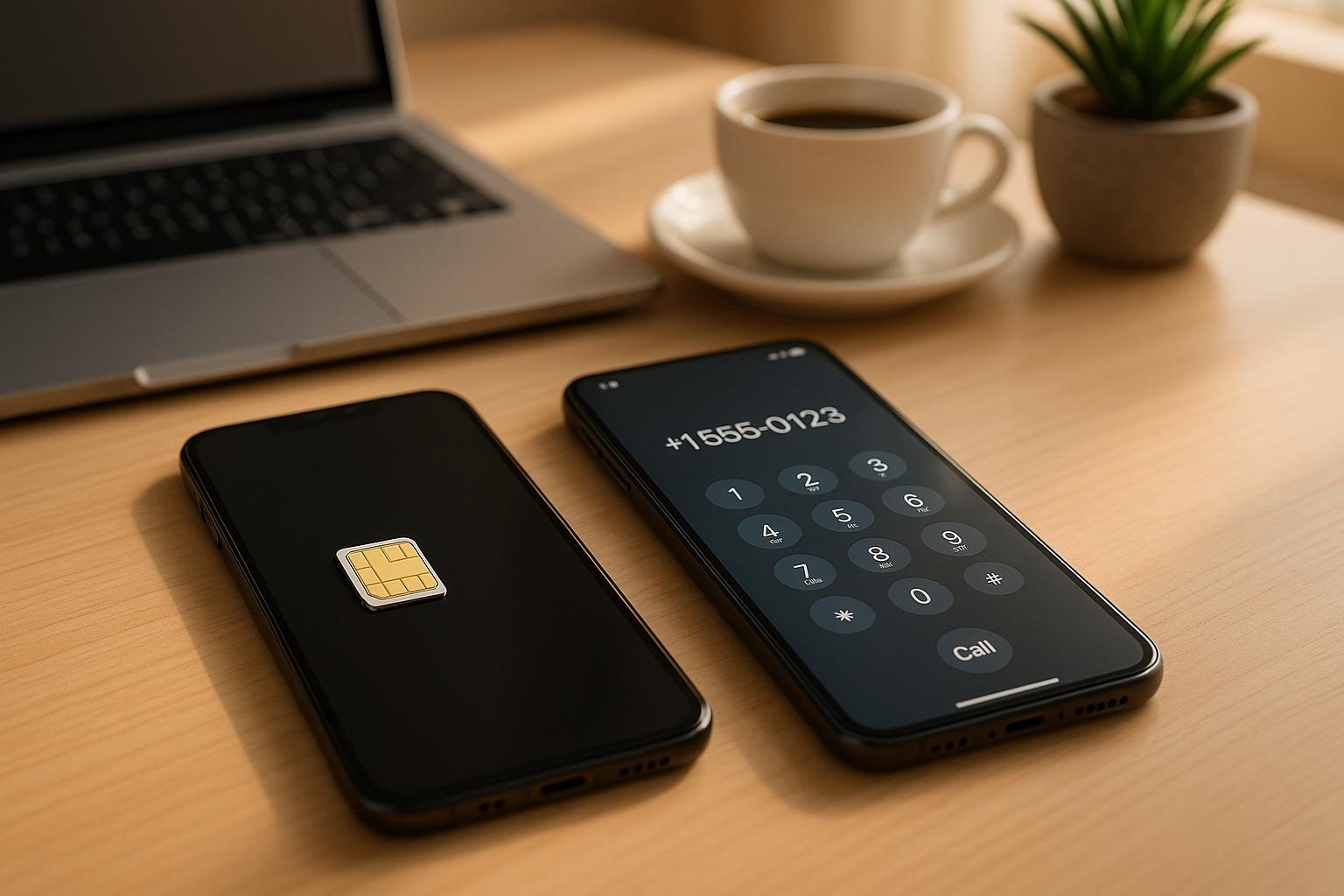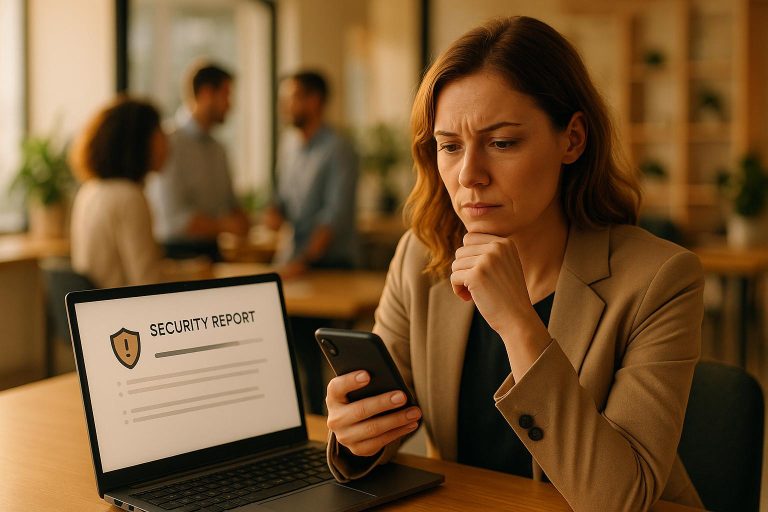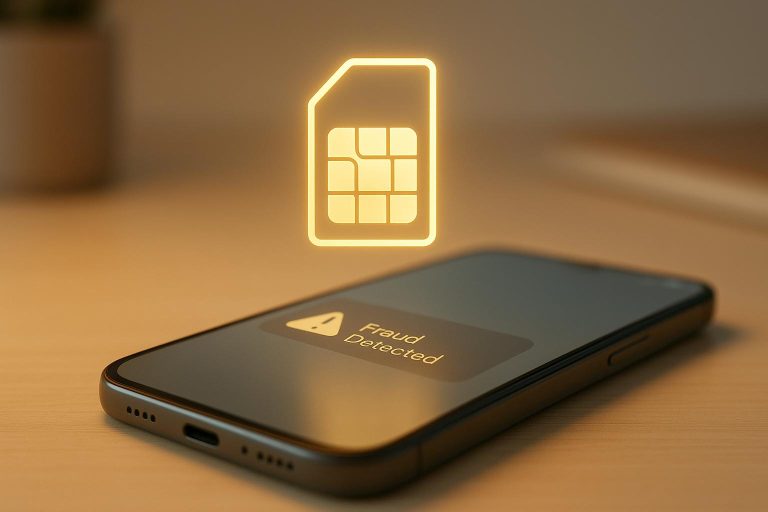Real SIM vs Virtual Numbers: Security Comparison Guide
Looking to secure your online accounts? Choosing between Real SIM cards and Virtual Numbers for SMS verification can make a big difference. Here’s what you need to know:
- Real SIM Cards: Offer physical security and carrier-level protections but are vulnerable to SIM swap attacks. They rely on PINs, PUK codes, and sometimes biometrics for authentication.
- Virtual Numbers: Operate digitally, reducing risks like theft or cloning. They use encryption, remote provisioning, and advanced authentication methods but may still face phishing risks.
Quick Comparison:
| Security Aspect | Real SIM Cards | Virtual Numbers |
|---|---|---|
| Physical Security | Vulnerable to theft or loss | Immune to physical tampering |
| Encryption | Basic symmetric encryption | Advanced digital encryption (TLS) |
| Authentication | PIN/PUK codes, sometimes biometrics | Multi-layered digital methods |
| Fraud Risk | Prone to SIM swap attacks | Avoids SIM swaps, but phishing risks |
| Access Control | Tied to physical SIM and device | Remote management across devices |
Key Takeaway:
Real SIM cards are reliable but come with physical risks. Virtual numbers offer flexibility and privacy but require strong digital safeguards. The best choice depends on your specific needs and security priorities.
eSIM vs Physical SIM: Which One is Better for You?
1. Real SIM Card Systems
Real SIM cards have long been the cornerstone of mobile security, holding key data that carriers rely on for user authentication. Each SIM card is embedded with a unique 17-digit code that identifies the country of origin, the service provider, and the individual user ID [5].
The security of these systems is built on multiple layers of protection. At the heart of this setup are two critical passwords: the Personal Identification Number (PIN) and the Personal Unblocking Key (PUK) [5]. When configured correctly, these features create a solid defense against unauthorized access.
"SIM-based authentication secures user identification and offers ease of use compared to hardware tokens. SIM-based authentication is difficult to bypass, since it links authentication directly to a user’s phone number, user mobile device and SIM card."
Despite their strengths, real SIM cards are not without vulnerabilities. A worrying trend has emerged in recent years: SIM swap attacks. According to FBI reports, these incidents surged from 320 cases between 2018 and 2020 to a staggering 1,611 cases in 2021. The financial impact? Over $68 million in losses [4].
To strengthen SIM card security, experts suggest adopting the following measures:
| Security Feature | Function | Implementation |
|---|---|---|
| SIM PIN Lock | Blocks unauthorized SIM use | Activate via your phone’s settings |
| Port Freeze | Prevents unauthorized carrier changes | Contact your mobile provider |
| Account Passcodes | Adds an extra layer of authentication | Set up with your service provider |
| Number Transfer Protection | Protects against number porting fraud | Enable through carrier services |
"Set a SIM PIN, enable transfer protection, and prefer authenticator apps over SMS for 2FA."
- Yaniv Masjedi, Contributing Cybersecurity Writer [6]
Physical SIM cards, with their storage limited to just 256KB [5], hold only minimal sensitive data. This limitation, combined with carrier protocols and user safeguards, provides a baseline of security for mobile authentication. However, as threats evolve, so must the strategies to protect against them.
Next, we’ll look at how virtual number systems tackle these security concerns.
2. Virtual Number Systems
Virtual number systems bring a modern twist to SMS verification by leveraging digital infrastructure and advanced security measures to safeguard user data. Unlike physical SIM cards, which come with risks like theft or cloning, virtual numbers operate through digital protocols designed to minimize such vulnerabilities.
At the heart of their security framework are several key components:
| Security Component | Function | Use |
|---|---|---|
| Data Encryption | Keeps message content secure | Implements end-to-end encryption |
| Secure APIs | Blocks unauthorized access | Uses OAuth 2.0 and API key authentication |
| Regular Audits | Detects potential weaknesses | Combines automated and manual security reviews |
| Access Controls | Regulates user permissions | Relies on role-based authentication systems |
In the U.S., virtual number systems must adhere to strict regulations, including the Telephone Consumer Protection Act (TCPA) and other data protection standards. These rules ensure secure SMS communication and require thorough record-keeping practices. This regulatory framework is crucial in a digital landscape where 560,000 new malware threats emerge daily [7].
One of the key advantages of virtual numbers is their digital activation, which significantly reduces the risks of tampering compared to traditional SIM cards [8]. In addition to regulatory compliance, these systems feature several advanced security measures:
- Remote Provisioning: Enables immediate deactivation if a number is compromised.
- Built-in Encryption: Shields messages from unauthorized interception.
- Digital Authentication: Adds extra layers of verification for enhanced security.
These safeguards are especially critical when you consider that people are 35 times more likely to read a text message than an email [9]. Secure SMS verification has become a cornerstone for modern digital services, ensuring both convenience and protection in an increasingly connected world.
sbb-itb-070b8f8
Direct Comparison
When looking at the security of real SIM cards versus virtual numbers, several factors highlight their strengths and weaknesses. This comparison builds on the earlier discussions about each system’s security features.
| Security Aspect | Real SIM Cards | Virtual Numbers |
|---|---|---|
| Physical Security | Relies on physical protection; vulnerable to theft if not properly safeguarded | Immune to physical theft due to lack of a tangible component |
| Encryption | Utilizes symmetric encryption protocols | Employs secure digital protocols, such as TLS and SRTP |
| Authentication | Traditional PIN/PUK codes, sometimes with biometric options | Multi-layered digital authentication methods |
| Fraud Risk | Prone to SIM swapping, with $68M in losses reported by the FBI in 2021 [4] | Avoids SIM swapping but still exposed to phishing and digital threats |
| Access Control | Requires the physical SIM card and device for access | Remote management allows use across multiple devices |
| Regulatory Compliance | Governed by telecom regulations | Adapts to evolving digital communication standards |
The risks tied to these differences have been highlighted in real-world incidents. For example, in January 2024, the U.S. Securities and Exchange Commission suffered a SIM swap attack that compromised its social media accounts [2]. Similarly, in January 2022, a Tampa resident lost cryptocurrency after attackers intercepted two-factor authentication codes using vulnerabilities in traditional SIM systems [4].
"SIM swapping is one reason why a phone number may not be the best verifier of your identity. It’s a breachable authenticator. Adding additional layers of protection could help keep your accounts – and your identity – safer." – Norton [4]
Here’s a quick breakdown of the key takeaways:
Real SIM Cards:
- Depend on physical security and carrier-level protections
- Use established encryption protocols
- May include biometric registration for added safety
Virtual Numbers:
- Can be provisioned and deactivated remotely
- Use advanced encryption protocols like TLS and SRTP
- Eliminate risks tied to physical tampering
- Benefit from fast, remote security updates
However, vulnerabilities persist. Experts estimate that over a billion SIM cards worldwide are still at risk of Simjacker attacks, particularly in regions with outdated mobile infrastructure [2]. This highlights the importance of regular updates for virtual number systems, which can adapt more readily compared to the static nature of real SIM cards.
The financial stakes are also considerable. According to the Communications Fraud Control Association (CFCA), Voice Interconnect Bypass fraud cost the global economy around $5.06 billion in 2023 [12].
Both systems require tailored security strategies. Virtual numbers need robust encryption methods like SRTP and TLS [11]. On the other hand, real SIM users should focus on physical security, enforce PIN protection, and perform regular security checks. By addressing the unique vulnerabilities of each system, users can strengthen SMS verification security and reduce risks.
Conclusion
When it comes to SMS verification security, the choice between real SIM cards and virtual numbers depends on your specific needs, as both options offer distinct advantages. Real SIM cards stand out for their reliability, with SMS boasting an impressive 98% open rate compared to email’s 20–30% range[13]. This reliability becomes particularly evident in scenarios like international operations, testing environments, and privacy-sensitive applications.
Virtual numbers, on the other hand, shine in certain use cases:
- International Business Operations: Ideal for businesses needing numbers from multiple countries for verification purposes[14].
- Development Testing: Useful for teams requiring temporary verification solutions.
- Privacy-First Applications: Perfect for users prioritizing the protection of personal information.
"Using temporary phone numbers for SMS verification is becoming increasingly popular, especially among those who value privacy and security online." – Eric Rodriguez[13]
Real SIM cards offer robust encryption and carrier-level protections, while virtual numbers provide unmatched flexibility and privacy. Emerging eSIM technology, with features like remote provisioning, continues to align with GSMA standards, offering a glimpse into the future of SMS security[15].
To enhance your SMS security, consider these practical tips:
- Use strong PINs or passwords to secure your accounts[10].
- Keep your device updated with the latest firmware and security patches[10].
- Enable VPN protection when using public networks[1].
- Choose providers that enforce strict identity verification measures[15].
The future of SMS verification security lies in blending the strengths of both real SIM cards and virtual numbers while integrating advanced safeguards. As technology progresses, innovations like stronger encryption and multi-factor authentication will continue to bolster the safety and reliability of SMS verification.
FAQs
What is a SIM swap attack, and how can I protect my SIM card from being targeted?
A SIM swap attack occurs when a hacker convinces your mobile carrier to transfer your phone number to a SIM card they control. This is often achieved through social engineering, where the attacker uses personal details – possibly obtained from data breaches or social media – to impersonate you. Once they control your number, they can intercept calls and texts, including one-time passwords, to break into sensitive accounts or commit fraud.
Here’s how you can safeguard yourself against this type of attack:
- Set up a PIN or security code with your mobile carrier to make it harder for anyone to make unauthorized changes to your account.
- Use strong, unique passwords for all your online accounts, ensuring they’re difficult to guess.
- Enable two-factor authentication (2FA) on your accounts. Whenever possible, use an authentication app instead of relying on SMS-based codes.
- Be wary of phishing attempts or unsolicited requests asking for personal information.
- Keep an eye on your accounts for any unusual activity that could indicate a breach.
By staying alert and implementing these security measures, you can make it much harder for attackers to carry out a SIM swap.
What are the privacy and security benefits of using virtual numbers for SMS verification?
Using virtual numbers for SMS verification comes with several privacy and security perks:
- They shield your personal phone number, helping you avoid spam, phishing scams, and unwanted telemarketing calls.
- Since virtual numbers aren’t tied to physical SIM cards, they’re less susceptible to interception or SIM-swapping attacks.
- Your real number stays safe from online databases, reducing the risk of data breaches.
- They work globally, letting you receive verification codes no matter where you are – no local SIM card required.
These benefits make virtual numbers a practical way to safeguard your personal details when interacting with online platforms.
How do virtual numbers comply with regulations, and why is this important for businesses with global operations?
Virtual numbers are designed to meet regulatory standards by requiring businesses to fulfill Know Your Customer (KYC) obligations and comply with local telecommunications laws. This usually means submitting valid identification and proof of business legitimacy during the setup process. These steps help ensure that virtual numbers are used responsibly and within the boundaries of legal guidelines.
For companies with international operations, staying compliant is critical to sidestepping risks like service disruptions, financial penalties, or harm to their reputation. Adhering to these regulations not only supports secure and dependable communication but also helps prevent fraud and strengthens trust with customers.







